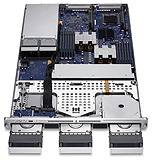With the success of iTunes and iPods, not to mention MacBook, you’d think Apple wouldn’t be that interested in the Xserve — an item that contributes a relatively minuscule amount to the company coffers. In fact, it hasn’t been covered in a Snapshot for a couple of years.
Server Snapshot: Sure Apple is now best known for its iPhones and iPods, but that doesn’t mean its server room offerings aren’t worthy of consideration. Xserve, MacPro and its storage products are all solid data center contenders.
Yet Apple has been working hard on its server platform. In the past year or so, it updated its server OS and has added Intel Nehalem processors to Xserve. In addition, it has made its Mac Pro desktop hardware available as a tower server. Finally, the company has continued to invest in improved storage systems for its user base.
Xserve
At the end of 2006, Apple introduced the first Intel Xeon processor-based Xserve model. Since that time, it has continued to add the latest and greatest from Intel. The newest Xserve, for example, comes with Xeon 5500 series processors.
 |
| The Apple Xserve Source: Apple
|
“Our most recent release has a lot of new technology which provides a big boost in performance and more memory bandwidth,” said Doug Brooks, the Xserve product manager at Apple. “Customers include education, science, research, federal government and creative customers in printing, graphics, media, video and post production.”
Apple positions this 1U machine as a complete package — everything you need in one box. The company web site pushes two basic versions:
A server with one 2.26 GHz quad-core Nehalem processor with 3 GB of memory, one 160 GB 7200 rpm SATA drive, Mac OS X server software and unlimited client licenses for $2,999; or one with the same basic specs except for two 2.26 GHz Nehalems for a price of $3,599.
| Recent Server Snapshots Egenera Fujitsu Unisys NEC Dell HP Lenovo IBM Sun |
The current operating system in the Xserve is known as Leopard, version 10.5 of the Apple server software. It took over from the Tiger OS (10.4). Compared to its predecessor, Leopard provides a streamlined interface that makes it easier for those who lack server administration experience to set up the server. Further, it comes with lots of collaboration software (such as a Wiki server), and a media processing engine to automate the capture of content and its publication.
This will be supplanted by version 10.6 in September that is codenamed Snow Leopard. This takes many of the features of Tiger and Leopard a stage further. The Mac OS X Snow Leopard Server will include Podcast Producer 2 for automating the creation and publishing of podcasts, and Mobile Access Server for secure access to firewall-protected network services for iPhone and Mac. Version 10.6 extends the 64-bit features of the OS all the way into the core to take full advantage of multi-core processors. Other features include Wiki Server 2, a new Address Book Server, iCal Server 2, (web-based calendar access) and a Mail Server engine. According to Brooks, it will be up to twice as fast as Leopard.
Apple Storage
Apple has also been working hard on storage support. On the Xserve side, the company released a 128 GB solid state drive (SSD) option. As it comes on an internal RAID card, it doesn’t take up a hard drive bay. This SSD, though, isn’t intended for primary storage. Rather, it operates as a fast, low-power boot drive with the OS loaded onto it. It costs $500.
“The SSD gives 100 MB a second-read performance, and random access performance is up to 20 times faster than a SAS drive,” said Brooks.
Additionally, the company has updated its SAN file system with the release of Xsan 2. This is clustered file system software that helps to create shared storage environments used in IT and video editing. XSan 2 requires a Fibre Channel (FC) SAN network and a metadata controller that typically runs on Xserve.
While Apple continues to provide storage software, it is no longer in the storage hardware business. The web site advertises the Promise VTRAK RAID storage system, which is fully compatible with Xserve and Xsan 2.
Mac Pro
As well as the Xserve, Apple has one other server hardware offering. It’s Mac Pro desktop is now being offered as a server (i.e. it comes loaded with the Mac OS X Server software). According to Brooks, this has been available for some time but the company is now putting more of a spotlight on it. Mac Pro pricing starts at $2,499.
“Xserve is a rack-mounted product, and some SMBs prefer a tower model,” said Brooks. “We support our server software on the Mac Pro and the Mac Mini. The Mac Pro has all of the horsepower of the Xserve and most of its features except a redundant power supply and lights out management.”
Apple’s Servers, At a Glance
| Product Name | Base Configuration | Base Pricing |
| Xserve | Choice of Quad-Core (2.26 GHz Quad-Core Intel Xeon “Nehalem” Processor) with 3GB RAM or 8-Core (Two 2.26GHz Quad-Core Intel Xeon “Nehalem” processors) with 3GB RAM, 160GB 7200-rpm Serial ATA drive module and Mac OS X Server v10.5 Unlimited-Client Edition | Starting at $2,999 |
| Mac Pro | Choice of Quad-Core (One 2.66GHz Quad-Core Intel Xeon “Nehalem” processor) with 3GB RAM or 8-Core (Two 2.26 GHz Quad-Core Intel Xeon “Nehalem” processors) with 6GB RAM, 640GB HD, 18x double-layer SuperDrive and NVIDIA GeForce GT 120 512MB video card | Starting at $2,499 |

